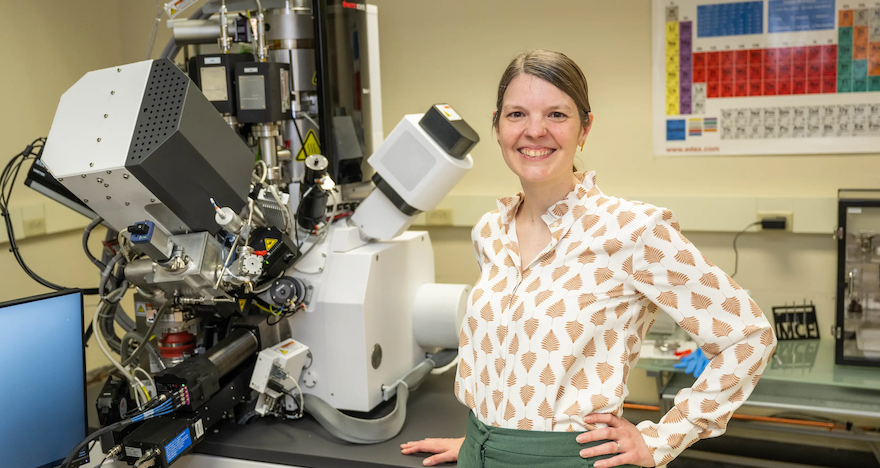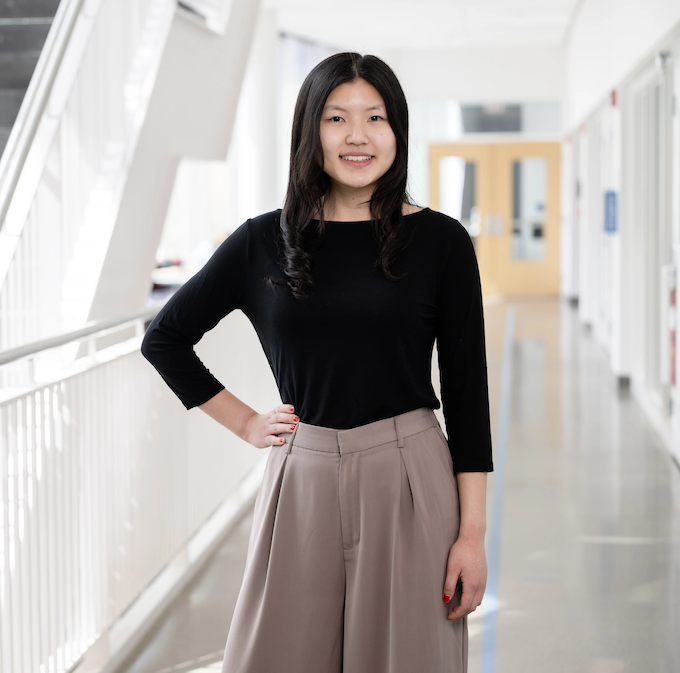Curious Minds, Confident Mentors Drive Success in STEM
Kelly Saavedra
Mar 26, 2025

Carnegie Mellon University is home to many talented women making significant strides in science, technology, engineering and math (STEM) fields. Among them are Amanda Krause and Katherine Wu, whose journeys are testament to the role of supportive communities in successful engineering careers.
Not only are these exceptional women advancing the frontiers of innovation, they are passionately inspiring the next generation of scientists, technologists, engineers and mathematicians to make their own lasting marks on the world. Their achievements are proof that when curious minds meet the right encouragement, the only limits that exist are in the imagination.
Solving practical puzzles: Krause advances materials science for a sustainable future
Amanda Krause is an assistant professor in the Department of Materials Science and Engineering (MSE) who was always good at math. Her desire to apply it practically to make a tangible impact on the world around her inspired her to pursue a career in STEM.
“Engineering is a way for me to leverage my strength in math to make meaningful contributions. It’s a way to solve puzzles, and I enjoy that,” she said.
Krause did summer work alongside a research scientist who pushed her to think more deeply about what she was working on, steering her toward becoming a researcher herself.
“He gave me projects that made me question things I’d already accepted. It made me realize, first of all, that I was capable of doing research, and second of all, that I had a passion for it,” she said.
Krause is a recipient of the NSF CAREER award and the George Tallman Ladd Research Award. Her groundbreaking work involves enhancing the mechanical and thermal properties of ceramics used in extreme environments.
“Materials science is all about how we process materials to make them perform well. For example, how do we create a metal or ceramic with a particular strength so it doesn’t break in operation? In wood, you have grains that determine how it will break. Metals and ceramics have a similar grain structure,” she explained. “When you’re processing metal, whether you’re melting it down or casting it, you’re changing the grain size and ultimately changing the strength. My research is about understanding that relationship.”
Everything you teach them, they’ll go out and multiply. It’s fun and rewarding to watch them develop into independent researchers.
Amanda Krause, Assistant Professor, MSE
Recently developed microscopes are enabling her to challenge old theories about grain growth.
“There are these old laws that have been around since the 1950s that dictate if you do this, you should get this grain size as a result. Now that we have the right microscopes, we’re testing those theories and finding they don’t apply,” she said. “We haven’t yet figured out what laws to write, but that’s the part that is really exciting for me. For the first time, we’re trying to figure out what determines the final grain size after processing.”
She’s also excited about new methods that reduce the time it takes to make materials by reaching a high temperature in seconds rather than hours. These are potentially transformative methods in terms of sustainability, reducing energy consumption for making parts that go into airplane engines, turbines for power generation or vehicles.
“If we can find effective ways to process materials to make them really strong, that’s going to impact a lot of different fields,” she said.
She’s thrilled to see her field trending toward how to make manufacturing processes better for the environment, but she gets the most satisfaction out of the impact she’s having on her students.
“Everything you teach them, they’ll go out and multiply,” she said. “It’s fun and rewarding to watch them develop into independent researchers.”
Collaborating with art teachers to integrate creativity into engineering education is also fun, she said. Through her outreach activities at Pittsburgh public schools and through the Leonard Gelfand Center, students learn the science of working with clay and how to make ceramics less likely to break.
“Most engineering students don’t think of themselves as creative people. They think of creativity as something for artists. They see it as a characteristic rather than a skill,” she said. “My goal as an instructor is to inspire people to think of creativity as a skill they can learn, practice, and grow.”

Bridging materials science and biomedical engineering: Wu’s device helps toddlers with cerebral palsy
Katherine Wu dreamed of having a career in STEM from an early age, but she wasn't sure which field until engineers at Carnegie Mellon helped her envision her own path.
“I had a strong interest in science, technology, engineering and math, and I was eager to develop that curiosity,” she said. “Hearing from people at CMU about what they were able to do with their engineering degrees allowed me to envision myself on that same path. To this day, I still maintain those connections. Continuing to foster that mentorship is important to me.”
Information sessions during Orientation Week ultimately inspired her to study materials science and engineering with an additional major in biomedical engineering.
Wu is most proud of her role as the president of the Society of Women Engineers, where she leads an executive board of 20 members and oversees a general body of over 300 members. She has successfully increased member engagement by 50% through activities and events from making friendship bracelets and gingerbread houses to bringing in alumni panels.
“We also put on many events that I feel are really empowering and allow us to connect with the community,” she said.
Recently, she oversaw a biomedical engineering workshop where middle school children were designing prosthetics for dogs that had developed a degenerative disc disease.
“They were incredibly eager to participate and asked a lot of questions,” she said. “They brought in stuffed animals. They used a variety of materials to craft the prosthetics. It was both an arts and crafts project and a valuable learning experience, and it was so inspiring to watch them participate with so much enthusiasm.”
Her capstone project in biomedical engineering involves creating a device to help children with cerebral palsy regain motor function in their affected hand. The project considers the needs of the children, parents, hospitals and therapists, and is currently in the prototyping stage.
With such a busy schedule, maintaining work-life balance is important to Wu, who engages in group exercise classes on campus, such as yoga, to stay in touch with her overall health. Additionally, she is taking an acting class to explore a different side of herself, which has helped her build confidence and express herself in new ways.
“I figure if I can sing in front of people, I can pretty much do anything, right?” she said, laughing.
Wu will launch her career in an engineering role within the health care industry to gain technical experience. Then, she plans to get an MBA and eventually move into a managerial position.
“I think it would be really fulfilling to work toward a mission that's about alleviating pain or bettering human lives and health,” she said. “That's a pretty big motivator.”
For Women's History Month, Carnegie Mellon is featuring the work of women across the science, technology, engineering and mathematics fields.
